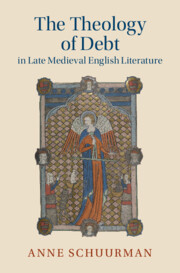Book contents
- The Theology of Debt in Late Medieval English Literature
- Cambridge Studies in Medieval Literature
- The Theology of Debt in Late Medieval English Literature
- Copyright page
- Dedication
- Contents
- Acknowledgements
- Abbreviations
- Introduction
- Chapter 1 Counterfeit Money
- Chapter 2 Secret Debts
- Chapter 3 Home Economics
- Chapter 4 “What is ynogh to mene”
- Chapter 5 Piers Plowman and the Inappropriable
- Epilogue
- Notes
- Bibliography
- Index
- Cambridge Studies in Medieval Literature
Chapter 2 - Secret Debts
Credit and Faith in the Spendthrift Knight Romances
Published online by Cambridge University Press: 04 January 2024
- The Theology of Debt in Late Medieval English Literature
- Cambridge Studies in Medieval Literature
- The Theology of Debt in Late Medieval English Literature
- Copyright page
- Dedication
- Contents
- Acknowledgements
- Abbreviations
- Introduction
- Chapter 1 Counterfeit Money
- Chapter 2 Secret Debts
- Chapter 3 Home Economics
- Chapter 4 “What is ynogh to mene”
- Chapter 5 Piers Plowman and the Inappropriable
- Epilogue
- Notes
- Bibliography
- Index
- Cambridge Studies in Medieval Literature
Summary
Chapter 2 reads the late medieval romance of the spendthrift knight as an exemplum of economic faith. A character borrowed from folklore, the spendthrift knight falls into debt through excessive largesse, and consequently into exile from the aristocratic community. The plot of the spendthrift romance is organized around the protagonist’s debt recovery and eventual social triumph when newfound wealth allows him to reclaim the status he lost through penury. I argue that what makes these romances amenable to and generative of commercial values is their valorization of credit, typically expressed in the narratives as honour, trouthe, and faithfulness. Such faithfulness is manifest primarily in a willingness to take economic risks, variously extending and accepting credit, in cycles of exchange that end up generating profit for the knight and for his community. Belief as such in relations of social and material exchange, belief that defies strict rationality and that makes risk and sacrifice both possible and profitable, motivates gifts and market transactions alike, and binds individuals in creditor–debtor relationships that are both reciprocal and hierarchical.
- Type
- Chapter
- Information
- The Theology of Debt in Late Medieval English Literature , pp. 50 - 81Publisher: Cambridge University PressPrint publication year: 2024

